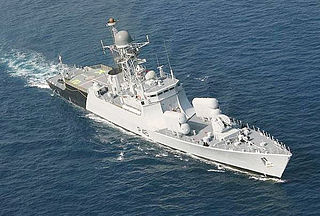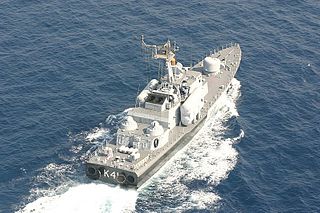
The Indian Navy is the maritime branch of the Indian Armed Forces. The President of India is the Supreme Commander of the Indian Navy. The Chief of Naval Staff, a four-star admiral, commands the navy. As a blue-water navy, it operates significantly in the Persian Gulf Region, the Horn of Africa, the Strait of Malacca, and routinely conducts anti-piracy operations and partners with other navies in the region. It also conducts routine two to three month-long deployments in the South and East China seas as well as in the western Mediterranean sea simultaneously.

INS Sindhurakshak was a Russian-made Kilo-class 877EKM (Sindhughosh-class) diesel-electric submarine of the Indian Navy. Commissioned on 24 December 1997, it was the ninth of the ten Kilo-class submarines in the Indian Navy. On 4 June 2010, the Indian Defence Ministry and Zvezdochka shipyard signed a contract worth US$80 million to upgrade and overhaul the submarine. After the overhaul, it returned to India from Russia between May and June 2013.

The Rajput-class guided-missile destroyers built for the Indian Navy are modified versions of Soviet Kashin-class destroyers. They are also known as Kashin-II class. The ships were built in the former Soviet Union after considerable Indian design modifications to the Kashin design. These included the replacement of the helicopter pad in the original design with a flight elevator, as well as major changes to the electronics and combat systems. Five units were built for export to India in the 1980s. All units are currently attached to the Eastern Naval Command.

INS Rajput was a guided-missile destroyer and the lead ship of the Rajput class of the Indian Navy. It was commissioned on 4 May 1980. It was the first destroyer of the Indian Navy. It was built by the erstwhile USSR. Commodore Gulab Mohanlal Hiranandani was her first commanding officer.

Sindhughosh-class submarines are Kilo-class diesel-electric submarines in active service with the Indian Navy. Their names are in Sanskrit, but in their Roman-alphabet forms sometimes a final short -a is dropped.

The Nilgiri-class frigates were updated versions of the Leander class, designed and built for the Indian Navy by Mazagon Dock Limited in Mumbai. Six ships were built between 1972–81. Vessels of the class formed the 14th Frigate Squadron. The lead ship INS Nilgiri was the first major warship to be built in India and was built in collaboration with Yarrow Shipbuilders of the United Kingdom.

INS Ranjit is the third of the five Rajput-class destroyer built for the Indian Navy. Ranjit was commissioned on 15 September 1983 and remained in service till 6 May 2019, when it was decommissioned.

The Khukri-class corvette is a class of corvettes intended to replace the ageing Petya II-class corvettes of the Indian Navy.

INS Khukri was the lead vessel of her class of corvettes, in service with the Indian Navy. The ship was named after INS Khukri, the only Indian Navy ship to be ever lost in combat.

The Abhay-class corvettes of the Indian Navy are the customised variants of the Soviet Pauk-class corvettes. The class was primarily intended for coastal patrol and anti-submarine warfare. Last ship of the class is expected to be decommissioned till 2025.

The Veer-class corvettes of the Indian Navy are a customised Indian variant of the Soviet Tarantul class. They form the 22nd Missile Vessel Squadron.

INS Kursura (S20) was a Kalvari-class diesel-electric submarine of the Indian Navy. It was India's fourth submarine. Kursura was commissioned on 18 December 1969 and was decommissioned on 27 February 2001 after 31 years of service. It participated in the Indo-Pakistani War of 1971, where it played a key role in patrol missions. It later participated in naval exercises with other nations and made many goodwill visits to other countries.
INS Vela (S40) was the lead ship of four diesel-electric Vela-class submarines of the Indian Navy. The submarine was commissioned on 31 August 1973 in Riga, Latvian SSR. Along with her sister ship Vagli, she spent almost 10 years undergoing a protracted refit by Hindustan Shipyard. After 37 years of service, the submarine was decommissioned on 25 June 2010. The submarine was claimed by the Eastern Naval Command to be the oldest operational submarine in the world at the time of her decommissioning.
INS Vagli (S42) was a Vela-class diesel-electric submarine of the Indian Navy, commissioned in 1974. Along with her sister ship Vela, she spent almost 10 years undergoing a protracted refit by Hindustan Shipyard. After 36 years of active service, INS Vagli was decommissioned on 9 December 2010.
INS Ajay (P34) was an Abhay-class corvette, in service with the Indian Navy. She inherited her name from INS Ajay, the first warship built in independent India, which served in the Navy from 1960–1974.

The Indian Navy has been focusing on developing indigenous platforms, systems, sensors and weapons as part of the nation's modernisation and expansion of its maritime forces. As of November 2023, the Indian Navy has 67 vessels of various types under construction including destroyers; frigates; corvettes; conventional-powered and nuclear-powered submarines and various other ship, and plans to build a strong navy of 200 vessels and 500 aircraft by 2050. According to Chief of Naval Staff's statement in December 2020, India has transformed from a buyer's navy to a builder's navy.













